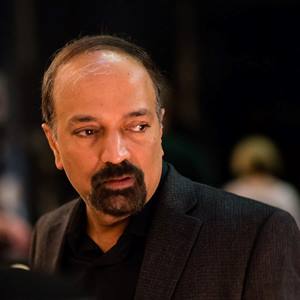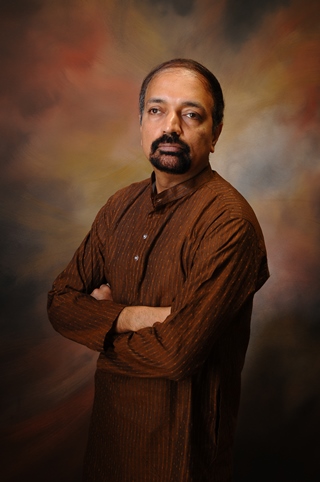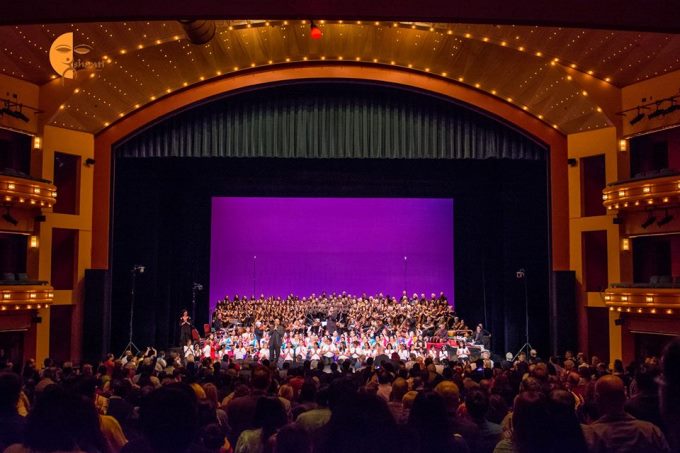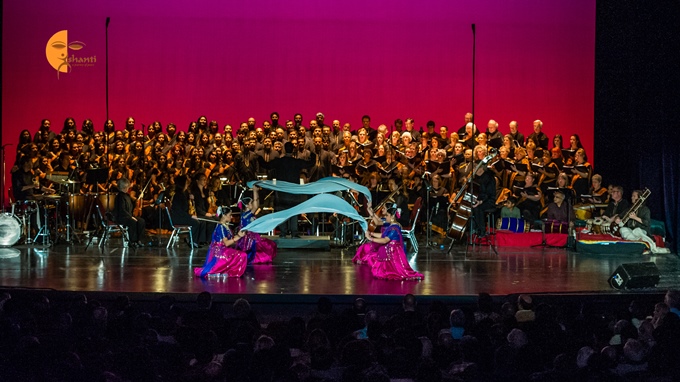Acclaimed Shanti Choir to perform in Atlanta on Saturday, Nov. 8: An interview with the composer and director Kanniks Kannikeswaran

Cincinnati-based Kanniks Kannikeswaran has been steadily gaining reputation for the last decade as the creator and director of the acclaimed production 'Shanti: A Journey of Peace.' In addition to working as adjunct faculty of music at the College Conservatory of Music, University of Cincinnati, Kannikeswaran now spends all his time composing, singing, teaching, and leading the Shanti choir in performances all over the US. He will be presenting the Shanti choir in collaboration with a Western choir for the first time in Atlanta on Saturday, November 8, 2014.
Indian music is monophonic by nature. Very few Indian-born music composers and arrangers have ventured and succeeded in creating large choral and instrumental ensembles that are effective. First and foremost, such efforts require a fertile mind to create compositions. Then, they also require exceptional ability of a music arranger to work with combining diverse vocal and instrumental layers to create beautiful sound. The Shanti choir, led by composer, music arranger, and director Kanniks Kannikeswaran is an emerging example of high caliber creative work in the field of choral music.
Shuchita Rao spoke to Kanniks Kannikeswaran for Khabar about his journey in music.

Q. Were you born and brought up in India? Tell us your educational background and interests in music?
A. I was born and raised in Madras (now Chennai). I finished my BTech at IIT Madras in 1984. I learned Indian classical music when I was in school. While in IIT, I was active in college bands. I moved to the US in 1984, finished my masters in Engineering and in Business in the US, and later completed my doctoral work in Indian music at the University of Madras. I live in Cincinnati and serve as an adjunct faculty of Music at the College Conservatory of Music, University of Cincinnati.
Q. What attracted you to choral music and the idea of starting an Indian choir?
A. Indian music is all about individual self-expression. Western music has centuries worth of music arranged for choirs and ensembles. In the early 1990s I was creating music based on ragas with Western orchestration, when some friends of mine suggested that I start a choir. This led to my first choral production ‘Basant’ in 1994. It has been 20 years since. Our choir in Cincinnati is probably the first Indian one in the United States. We recently celebrated its 20th anniversary.
Q. Could you name the most inspiring musical influences in your life and describe how their music or teaching helped shape you into who you are today?
A. One thing that inspires me most is the fact that Muthuswami Dikshitar (1775-1835) actually wrote Sanskrit text to colonial tunes that came to India with the East India Company. This is actually mindboggling. There are 39 such compositions—which are both Indian and Western at the same time. This was a topic of my research and I was the first to record and archive all of these compositions with Indian voices and Western instruments. To imagine such innovation during the dark days of colonial rule is something. Then Tagore—who was so universal in his outlook—and then the musical ambassador of our lifetime, Pandit Ravi Shankar—all these great souls are sources of my inspiration and have influenced me in many ways.
Q. What do you enjoy most? Composing, teaching, or conducting and why?
A. It is hard to answer this question. I enjoy creating new works and have been doing it for years. There is a joy in teaching this work and getting a choir to perform it—getting voices to sound together and communicate the composition with expression. The greatest joy in teaching is when you communicate something complex and get an ‘aha’ moment when the teacher and the students become one in the space of knowledge!
Q. What are the most challenging and what are the most rewarding aspects of leading a choral ensemble?
A. When you lead a community choir you see a range of singing abilities ranging from skilled solo singers to those that are not at that level; one of the challenges is to ensure that everyone gets something from the choral experience. The reward is the sense of collective accomplishment at the end of a performance, when all that is left are hugs and tears of joy!
Q. And now tell us about the Shanti choir. How did it start out and how has it changed over the years?
A. In 1996, we created a new soundscape, that of Indian singers singing with traditional Western voices, and the result—literally a ‘new sound’—that was mind-blowing. I had then collaborated with Catherine Roma, a celebrated conductor in the Cincinnati area, in producing ‘The Blue Jewel’ which we performed in 1996, 1997, and 1999.
In 2003, I wanted to write something new.
For a long time I had had this image of presenting the 5,000 years of Indian cultural history using a large ensemble; a group of 100 singers with a Western orchestra and an Indian orchestra. This was a mental picture on a very large canvas. In 2004 this picture became a reality as we expanded our choir to a set of 80+ members of Indian origin living in the Cincinnati area. I collaborated with local Western choirs such as the Martin Luther King Coalition Chorale, St. John’s Unitarian Church singers, and more. The combined sound was unbelievable. We premiered to a packed house—3 performances in 2004—and then went on to do more.
We were invited by the Cincinnati Art Association to perform at the prestigious Aronoff Center in 2006. This time we had 90 singers of Indian origin and 60 from local choirs, and the total cast of the show was 250. We had an audience of 2,600.

I was then invited by friends in Allentown, PA to share this experience, and there we started a new choir; it was so moving to see people driving in from New Jersey area to participate in rehearsals. We performed Shanti there in 2006, and several Western choral singers drove all the way from Cincinnati to sing in Allentown, PA.
Then we performed Shanti in Houston, there with a 90-member choir of Indian origin and the 90-member United Nations choir. It was a historic occasion in 2010.
This year we celebrated Shanti’s 10th anniversary in Cincinnati. Again we had a 150-member choir. There are many new singers and some returning singers. Ajay Madwesh of Atlanta who had sung in Shanti in 2008 in Allentown came from Atlanta to sing again. So did Hareesh and Surekha from Houston.
Q. How many concert engagements has the choir done so far? Any awards?
A. I wrote and produced a creation called ‘Chitram, a Portrait of India’ for a smaller choir; ‘Chitram’ has helped us found Indian community choirs in several cities. Tampa, Fort Lauderdale, Houston again, Minneapolis, Toronto, etc. I wrote the work ‘Sangam to Silicon valley’ in Tamil which was performed at the annual meeting of the Tamil Nadu Foundation in Chicago this year.
One of the most notable landmarks is the founding of the first ever Surinamese Indian choir in the Netherlands in the Hague last year. We performed my work ‘Sharad – A celebration of autumn.’ I was invited again this year to perform the work ‘Ragas in Symphony,’ this time in collaboration with the Dario Fo choir (who have sung in Holland’s Got Talent) and the prestigious Residentie Orkest. It was a memorable experience.
There have thus been several concert/choral engagements over the years. I got the McKnight Fellowship, an Ohio Heritage Fellowship, the Just Community Award, a lifetime achievement award from the Geeva Foundation in Louisville, an award from the SRGMPDN Forum in D.C., and a special award from the Hindu American Foundation at a special performance on Capitol Hill.
Q. What is the repertoire of music that the Shanti choir presents? Do you select existing pieces or compose new ones? Do you like the works of any specific composers? What plans to include new composers?
A. I wrote Shanti in 2004. In Western terms, Shanti is an oratorio. It is a work for large choirs, orchestra, dancers, and multimedia, and storytelling. Shanti tells the story of Indian cultural history; it also presents a stark contrast between Shanti and Ashanti. There are several compositions in Shanti based on ancient Sanskrit chants (and newer Sanskrit lyrics), taranas, svarapadas, etc., based on ragas such as Yaman, Sarasvati, Durga, Kedar, Shri, Bhupali, etc. There is a choral tarana based on the Karnatic raga Vagadisvari. Shanti is a set story; it has stayed the same. The Ashanti segment in raga Shri is a very powerful one. There is a mallari in Gambhira Nattai (an instrumental piece), a short tillana in Desh, etc. And it is always performed by a ‘local cast’.
Q. Do you have a particular philosophy of choir training or conducting? What are the fundamental elements you try to cultivate in the choir and how do you go about developing those?
A. I focus on ‘togetherness,’ intonation (sruti shuddha), diction, and expression. There are certain warm-up techniques that I have developed over the years that help with intonation. Expression comes with understanding the context of what we are presenting.
Q. How much time do you devote to teaching a piece? How often does the choir meet on a weekly/monthly basis? What kind of work goes into practices and rehearsals?
A. The time per piece varies with the piece. We once learned a complex chaturang in Kkirvani for weeks together in Cincinnati. I taught the same composition (a slightly simplified version) to the Madras Youth Choir in a shorter period of time.

Q. What kind of instruments do you use for accompaniment? Do dancers join the performances and perform to live music from the ensemble?
A. In Shanti, we use a full-fledged Western orchestra with strings, woodwinds, percussion, and an Indian ensemble consisting of a sitar, veena, tabla, and mridangam. Almost all of Shanti is choreographed to dances from around India. Then there is multimedia and powerful imagery.
Q. Do you meld solo singing with vocal ensemble providing vocal support in the background?
A. The first time we performed Shanti, our lead vocalist was Lakshmi Shankar. We had the great honor of having her sing along with us. We miss her! Yes, we do have a few lead vocalist parts in each choral production. My daughter Vidita Kanniks has sung several times as a soloist. I sing lead sometimes.
Q. How do you deal with changes in membership in your ensemble—new people wanting to join the choir and old-timers leaving due to not being able to give enough time or other reasons? Do you hold auditions for new members?
A. Membership changes in choirs always happen. There is an informal audition process in place for getting new singers into the choir.
Q. What kind of funding have you received for your efforts?
A. Local organizations have always supported these performances—and we have had a history of performances in the last 10 years in various cities across the United States; and now Europe over the last couple of works.
Q. Have you collaborated with other international choirs? What was the experience like?
A. Yes, I did collaborate with the Dario Fo choir in the Netherlands and with several Western choirs in the United States. A recent work of mine in sultaal was performed by a choir in Chicago. Collaborating with Western choirs is a rewarding experience. The combined sound that we experienced in 1996 stays fresh every time we collaborate with a new group.
It was mind-blowing when the Dario Fo choir in the Netherlands performed my work in Darbari Kanada (by themselves) and with the Surinamese choir in ragas Bhairav and Madhuvanti and Yaman.
Q. I understand you have a performance coming up in Atlanta, GA. When and where will this happen?
A. We are performing at the Ferst Center, Georgia Tech on Saturday, November 8th at 6:30 pm.
Q. How many members will perform?
A. It is a huge performance. There are about 85 singers of Indian origin and several singers from many local Western choirs and instrumentalists—some from the Atlanta Symphony; the combined ensemble will be directed by the choral and orchestral director Huu Mai of the Unitarian Universalist Metro Atlanta North. We are recreating Shanti for the first time in Atlanta. Practice sessions have been going on for several weeks now. We started out with all Indian rehearsals where we learned the music by rote; then once the Western choirs joined us, we rehearsed at the Unitarian church—Metro Atlanta North.
It is an all-Atlanta cast and a recreation of the multicultural experience all over again. My daughter Vidita is a guest performer; there are four singers coming in from Houston. I have been flying in and out of Atlanta for several weeks now. Each session was an invigorating experience. The Western choir and the conductor have been great. There are several singers (both teachers and students and singers at various levels) that have given their time and energy. The entire performance is choreographed to a multigenre Indian classical dance (Kathak, Bharatanatyam, Kuchipudi, Odissi, modern, yoga, etc.) and several of Atlanta’s leading dance teachers have been involved in the production. There are more than 200 people in the cast. There is a huge team of volunteers as well.
Q. How long do you expect the concert to be?
A. It is about 90 minutes in length.
Q. What will be special about this concert?
The Atlanta cast sounds and looks great. We will be creating the combined multicultural soundscape all over again, yet with a distinct Atlantan flavor. We look forward to sharing this with Atlanta audiences. They will see something that they have never seen before.
For more information on the performance of Shanti in Atlanta, please see the following post on Khabar's Events Calendar:
http://www.khabar.com/events-calendar/IACA-Shanti-Indian-Western-musical-production .
[Posted on 11/5/2014.]
[The article above appears only on the website for November 2014, not in the November print/digital issues.]
Enjoyed reading Khabar magazine? Subscribe to Khabar and get a full digital copy of this Indian-American community magazine.
blog comments powered by Disqus










